Biology: The Study of Life… And What is More Important Than LIFE?!
UConn Storrs (Google Maps Location)
February 25, 2009
Ahhhh, home. Like the plants on view, I was rooted in this very building for four years. The smells… The sights… It was nice to be back “home.” Yes folks, I hold a biology degree from the University of Connecticut; an Ecology and Evolutionary Biology Bachelors to be exact, and I attended many classes here in the Torrey Life Sciences Building.
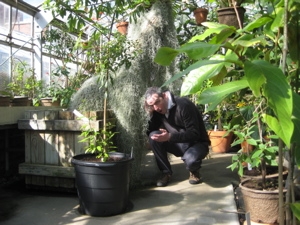
My slightly insane high school biology teacher used to say, by way of introducing his class, “Biology! The Study of Life! And what is more important than LIFE!?” He had a point… And I’ve honored him with my post’s title.
I was excited to check out the old stomping grounds again, but also a little weirded out. The campus has undergone some massive changes since the early 90’s when I ruled this place. (That’s right, I totally ruled.) But that wasn’t the weird part; just being back in the building and seeing the names of my old professors on the doors and peering into the labs I once worked in was a little odd.
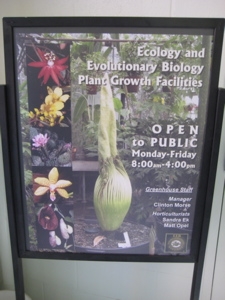
But I wasn’t there to reminisce. I was there to see (and smell, I suppose) the renowned UConn Greenhouses. Does this really rate as a museum? I say yes… Coupled with the cool ecological and evolutionary biology exhibits in the attached building, I would definitely argue for its inclusion here. Though really, who’s going to argue with me? This is my website and my “baby” darnit.
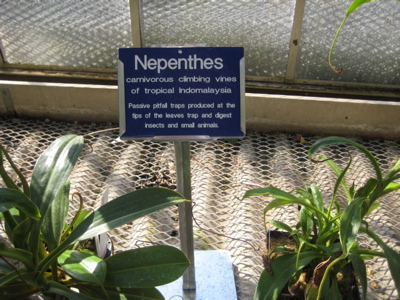
The greenhouses are impressive to say the least. I’ve seen greenhouses before, and a few have been included here on CTMQ. Of course, this being an uppity New England liberal university, they don’t refer to the greenhouses as mere greenhouses:
The EEB Plant Growth Facilities (ahem) house one of the most diverse teaching plant collections in the US. This outstanding collection is used extensively for teaching and research at the University of Connecticut. The Plant Collections are generally segregated into two groups – Research Collections and the General Collection which includes most of the diverse teaching materials the facility is noted for.
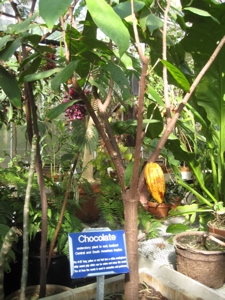
If anyone is more interested in the plants houses there, “each accession in the teaching collection has a corresponding web page on the EEB website, here. The detail and organization of the site is as equally impressive as the collections themselves. And certainly, since I’m incapable of doing so, if you want to learn anything of importance about a plant here, go there and check it out.
And if you’re REALLY gung-ho about this stuff, enroll and become a student there. The Ecology & Evolutionary Biology Greenhouse facilities house an average of 15-25 active research projects at any given time. Some of these projects are long-term research collections supporting the work of faculty members, others are multi-year projects for graduate student research. Project durations run the gamut from one semester to 10 years and longer in the case of some research collections.
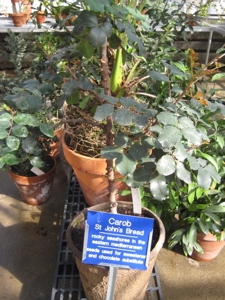
For the record, while I did take a few botany and plant related courses, I was more into evolutionary morphology of animals, particularly fish and the fish-amphibian evolutionary pathways. Fish are amazing animals and their diversity is astounding. I did a whole research project on… Wait, you don’t care. Long story short, I thought about interning at the Quinebaug Fish Hatchery in Plainfield and at one point was going to study lobster genetics in an effort to manipulate a population’s genome to weed out cannibalism and sexual aggression. I figured if I could do that (they are WAY too territorial to “farm”) I would become a millionaire.
But that never happened. Obviously.
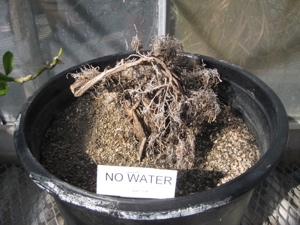
You can take a guide led tour here – organized tours of the facility are available to school groups, garden clubs and other interested groups during the week. These are typically about an hour in length and led by Greenhouse Staff or EEB Graduate Students. They do charge a fee though, and solo tours are always a bit dicey for me, so I opted to go it alone.
The plants are arranged in such a way that they surely make sense to botanists. Oh sure, certain plant groups are grown together, but phylogenetically speaking, plants don’t really work the way we laymen would think. Very recent DNA analyses are constantly turning the plant phylogenetic trees upside down and inside out. Many of these results are surprising and offer opportunities for further study.
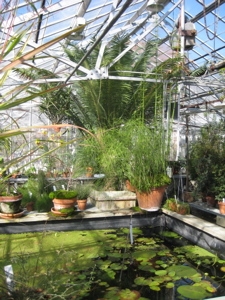
One hot area of current study is the evolution of flowering plants and… Oops, sorry, off on a nerd tangent again.
The greenhouses, as they often are, are hot. It was February in Storrs (always 10 degrees colder than anywhere else in the state at any given time and if it snows, be sure to add on an extra 5 inches when in Storrs) and I was sweating my epiphytes off. But I slowly wound my way through all three greenhouses (though only two are open to the public. I pulled my EEB diploma cred to access the third).
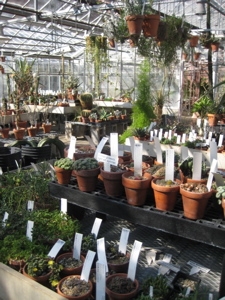
There are some really exotic and cool plants here. There is a massive collection of orchids – I remember being told back in the day that this was the largest orchid collection in the country? In New England? In Connecticut? I forget. But probably just Connecticut.
There is a whole room of staghorn plants. Another full of “ant plants” and yet another with every kind of carnivorous plant you can imagine. Since I was there in February, not too many plants were in bloom. But you can always check what’s in bloom these days at the EEB Greenhouse website’s In Bloom page. You’ll be impressed.
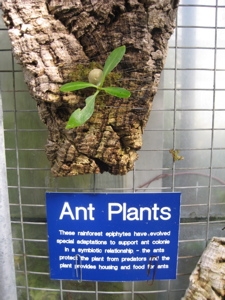
And if you happen to visit when the titan arum is in bloom, consider yourself lucky. Incredibly, stinkily lucky. You see, the last time time Amorphophallus titanum (titan arum) opened was here at UConn in the summer of 1994 – for a day. And before that, the last time in the Northeast was in the 1930’s, at the New York Botanical Garden. In fact, fewer than five dozen have flowered in the United States since the titan arum bloomed for the first time in cultivation at the Royal Botanic Gardens in Kew, England, in 1889.
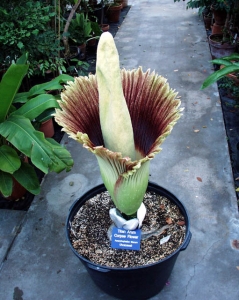
What’s more, the titan arum is known more infamously as the corpse flower (above). Why? The corpse flower is specifically adapted to attract carrion flies and beetles, which ferry pollen between plants so they can produce seed. The colors of the corpse flower – a sickly yellow and blackish purple – imitate rotten meat. The smell is powerful and unpleasant, with elements of old socks, dead fish, and rotten vegetables. In addition, the corpse flower is warm-blooded, heating itself up at the height of flowering, probably to help spread its putrid odor. It is irresistible to flies, which are tricked into thinking they’ve chanced upon a dead animal, and thus help pollinate the plant.
Awesome.
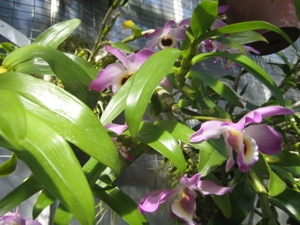
I spoke with the greenhouse manager for a little while and we had a great chat. Disclosure: I sort of know Clint Morse outside of the greenhouse, but I assure you he’s just as nice to anyone who visits.
I was excited to get over to the new biology building to check out the exhibits they have on display now. If you didn’t know, walking through any University biology building can be a very museumish experience. They always have stuff on display and whether your intention is to learn or just to see something cool, I suggest stopping by one if you’re in the vicinity. I know it sounds weird, but trust me.
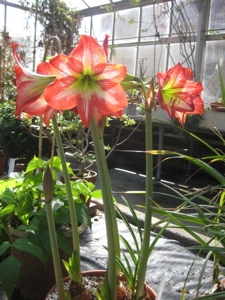
The only problem is that there will always be 20 year olds staring at you. And if you feel like taking pictures, they’ll immediately use social media to tell everyone about the creepy old guy taking pictures of bugs. I’m probably on some punk’s Facebook page after trying to take a decent picture with no one giving me the stink eye in it. I failed mightily.
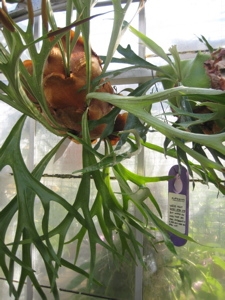
There were displays noting Darwin’s contributions to biology and then a few cases about preserving biological specimens. There was a beetle from 1894 that looked alive next too a case of black dust. That black dust was a bunch of butterflies collected only 30 years ago, but stored improperly. They were eaten by carpet beetles who then died and disintegrated.
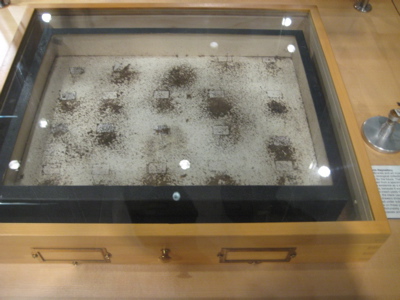
I was invited to view the awesome new collections rooms but declined. Again, this was due to my sort of knowing Clint in the greenhouse and being an alumnus… I’m not sure they are open to the public but I’d guess you’d be let in if you ask. I had a few more places to check out before driving back home to pick up my son.
I’m telling you, this is a really cool place to visit – especially in the spring and summer when everything is blooming. And I promise to do a more focused write-up of a visit to the various displays and collections at the Torrey Life Sciences Building someday.
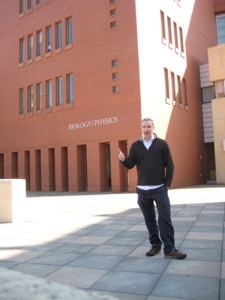
![]()

Leave a Reply